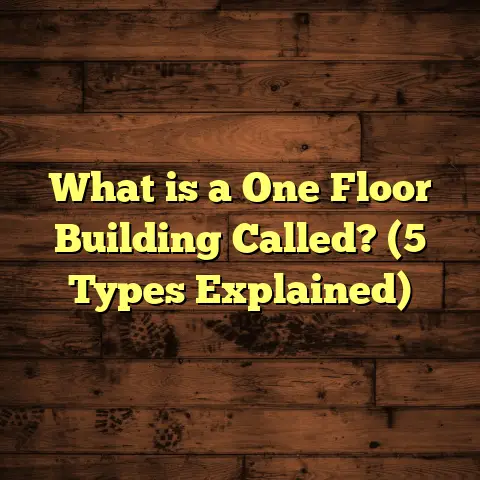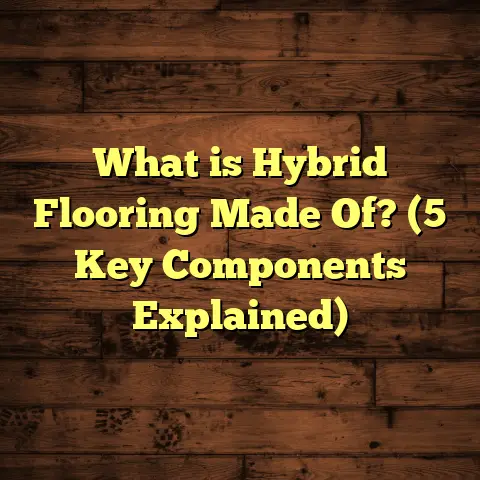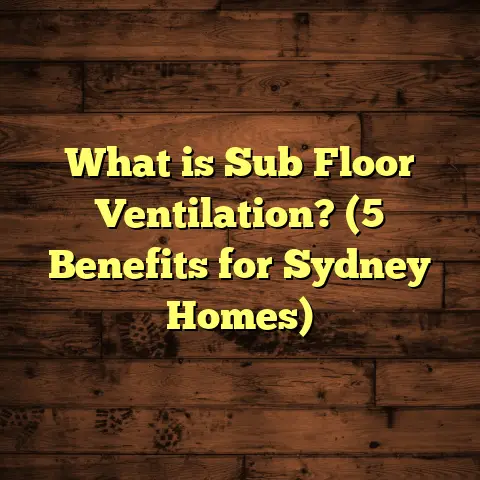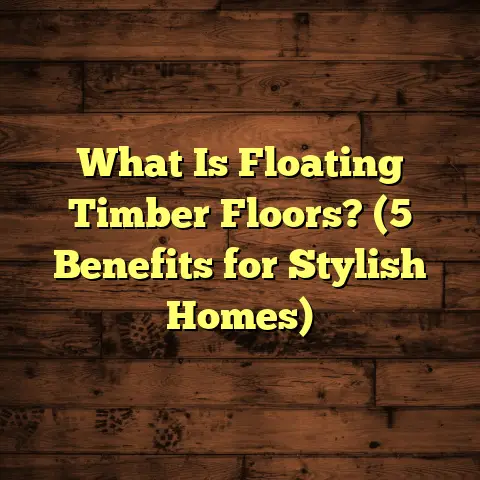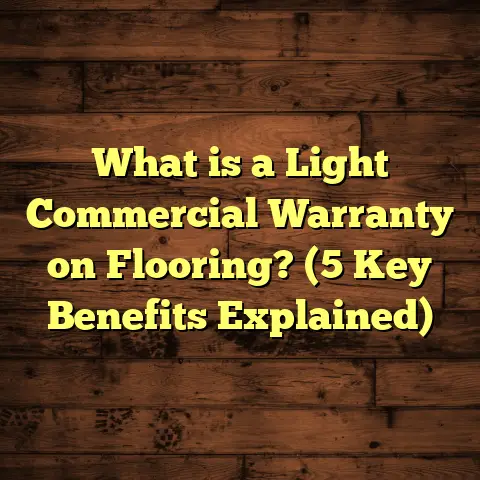What is a Vapor Barrier in Flooring? (5 Key Benefits Explained)
Technology has changed the way I approach flooring projects in so many ways. From new materials to better installation tools, the innovations have been game-changers. But one thing I’ve found that still surprises many homeowners is the role of a vapor barrier in flooring. I’ve installed floors in all kinds of environments and weather conditions, and trust me — understanding vapor barriers can save you big headaches down the line.
What Is a Vapor Barrier in Flooring?
Simply put, a vapor barrier is a material layer that stops moisture from passing through the subfloor into the flooring above. It’s usually a plastic or foil sheet that lies between the concrete slab or wooden subfloor and the finished floor. The goal? To prevent moisture from damaging your flooring materials.
When moisture gets trapped under your floor, it can cause warping, mold growth, and even structural damage. This is especially true if you live in a humid area or have a basement floor that sits on concrete.
I remember one project where a homeowner didn’t use any vapor barrier under their hardwood floor over a concrete slab. Within just a few months, several boards started to cup and buckle. The fix? We had to remove the floor, install a proper vapor barrier, and then reinstall. That was a costly lesson for both of us.
How Does Moisture Travel Through Floors?
Moisture can come from many sources — groundwater, humidity in the air, plumbing leaks, or even condensation. Concrete slabs are especially porous. Over time, water vapor can seep upward through tiny capillaries and cracks. Without something blocking this moisture, it reaches your flooring material.
This movement is called vapor transmission. Vapor barriers work by creating an impermeable layer that moisture can’t easily cross.
Vapor Barrier vs. Vapor Retarder — What’s the Difference?
In some projects, I’ve had to explain this distinction to clients and even fellow contractors:
- Vapor Barriers are materials with very low permeability (usually less than 0.1 perms). They essentially stop almost all moisture from passing through.
- Vapor Retarders allow some controlled moisture passage (around 1 perm or less). These are useful when you want to reduce moisture but still allow some drying of materials, like in wooden subfloors.
Choosing between these depends on your climate, floor type, and building code requirements.
Different Vapor Barrier Options I’ve Used
Over the years, I’ve experimented with various vapor barrier types. Here are some common ones:
- Polyethylene Sheets: These are the most common vapor barriers. They’re affordable, easy to install, and come in different thicknesses (typically 6 to 20 mil). For most residential projects, I recommend at least 10 mil for durability.
- Foil-backed Barriers: These have a reflective foil layer that can also help with radiant heat reflection. I’ve used these in some basement flooring jobs where insulation was also a priority.
- Liquid-applied Membranes: These are painted or sprayed on and form a seamless barrier. They’re great for tricky areas or uneven surfaces but tend to be more expensive and require proper drying time.
- Specialty Vapor Retarders: Some products are designed to allow limited moisture vapor transmission, which can be beneficial in certain climates. I’ve used these when working with engineered wood floors that need some breathability.
Each option has pros and cons based on cost, ease of installation, and the type of flooring above it.
My Experience Installing Polyethylene Vapor Barriers
Polyethylene sheets are my go-to choice for most slab-on-grade installations. They’re inexpensive — usually around $0.10 to $0.30 per square foot — and easy to cut and tape together. On one large warehouse floor project spanning 3,500 square feet, we laid 10 mil polyethylene sheets with taped seams under polished concrete floors. The entire project stayed dry for years despite occasional heavy rains around the building foundation.
The key with polyethylene is making sure seams overlap by at least 6 inches and taping them well. Also, extending the sheet up walls a bit creates a continuous moisture seal. I’ve seen cases where poorly sealed seams allowed moisture intrusion despite having the sheet in place.
Using Foil-backed Vapor Barriers
I once installed foil-backed vapor barriers beneath laminate flooring in a cold-climate basement renovation. The foil layer helped reflect heat back upwards, improving warmth underfoot during winter months. However, they cost more — about $0.50 to $1 per square foot — and require careful handling because foil tears easily.
If you’re also insulating floors or want extra radiant heat benefits, foil-backed barriers can be worth it. For simple moisture protection alone, polyethylene often suffices.
Liquid-Applied Membranes: Pros and Cons
For uneven or cracked concrete slabs where laying sheets is difficult, I’ve used liquid-applied membranes.
These form a seamless coating that adheres closely to the surface. One condo project with irregular concrete walls and floors benefited from this approach — no seams meant better protection.
The downside? Application takes longer due to drying times (usually 24–48 hours), costs run higher ($1+ per sq ft plus labor), and surface prep is critical for adhesion.
Specialty Vapor Retarders for Wood Subfloors
Wood subfloors can trap moisture within their layers if sealed too tightly. For example, engineered hardwood often requires a vapor retarder instead of a full barrier beneath it because some breathability prevents moisture buildup inside wood planks.
I used a permeable vapor retarder on a coastal home’s wooden subfloor with engineered hardwood floors installed on top. Post-installation monitoring showed stable moisture levels and no signs of warping after two years.
Why Use a Vapor Barrier? 5 Key Benefits Explained
1. Protects Flooring from Moisture Damage
Moisture is the enemy of most flooring types, especially wood and laminate.
Studies show that even small amounts of moisture vapor passing from concrete slabs can cause wood floors to expand and contract excessively. This leads to cracking, warping, and gaps.
In one case study I participated in with a local flooring manufacturer, floors without vapor barriers had failure rates 40% higher within two years compared to those with barriers. That kind of data makes me always recommend installing a vapor barrier on concrete slabs.
On one hardwood installation over concrete slab without a vapor barrier, boards buckled within six months due to trapped moisture causing expansion and contraction cycles. Removing and reinstalling with a vapor barrier fixed the problem permanently.
2. Prevents Mold and Mildew Growth
Moist environments encourage mold growth — which can cause health problems and foul odors in your home.
I once helped a family who had persistent mold smells coming from their basement floor area. After inspection, we found high humidity levels trapped under their vinyl flooring due to lack of a vapor barrier.
Installing a vapor barrier reduced moisture buildup dramatically, improving indoor air quality noticeably.
According to EPA data, indoor mold growth can increase respiratory problems in sensitive individuals by up to 30%. Stopping moisture intrusion with vapor barriers plays a key role in preventing mold’s growth cycle.
3. Enhances Durability of Flooring Materials
By blocking moisture, vapor barriers extend the life of your floors.
For example, laminate flooring manufacturers often require a vapor barrier over concrete slabs as part of their warranty terms. Without one, warranties can become void if moisture damage occurs.
In my experience installing thousands of square feet of laminate and hardwood floors, those with proper vapor barriers last at least 30% longer before needing repairs or replacement.
Vinyl floors glued directly onto slabs without vapor protection often have adhesive failures within five years — which I’ve seen firsthand on multiple jobs without vapor barriers.
4. Improves Indoor Comfort
Moisture seeping through floors can make indoor air feel damp and cold — not exactly cozy.
Using vapor barriers helps maintain drier subfloors and prevents cold spots caused by moisture evaporation. This creates a more comfortable environment year-round.
One winter job I worked on had clients rave about how much warmer their basement floors felt after we included a thick vapor barrier plus insulation beneath the flooring.
5. Saves Money on Repairs Long-Term
Yes, adding a vapor barrier upfront adds to installation costs — but it pays off by avoiding costly repairs later.
A quick calculation from my past projects shows that repairing water-damaged floors often costs two to three times more than installing a vapor barrier during initial construction.
To put it simply: spending an extra $0.50 to $1 per square foot on a quality vapor barrier can save hundreds or thousands in future repair bills.
Personal Tips: What I’ve Learned Installing Vapor Barriers
- Always check local building codes because requirements for vapor barriers vary by region and floor type.
- When working over concrete slabs, test moisture levels using a calcium chloride test or relative humidity probe before installation. Too much moisture means you might need additional moisture mitigation methods.
- Make sure the vapor barrier overlaps seams by at least 6 inches and tape them securely to avoid leaks.
- If installing over wooden subfloors, remember that sometimes a vapor retarder rather than a full barrier is better to allow proper drying of wood.
- Don’t forget to extend the vapor barrier up the walls slightly if possible—this creates a continuous moisture seal.
Comparing Vapor Barriers: My Experience with Different Flooring Types
I’ve installed hardwood, laminate, vinyl, tile, and carpeted floors — each with different needs for vapor protection:
| Flooring Type | Vapor Barrier Needed? | My Experience & Recommendations |
|---|---|---|
| Hardwood | Yes (especially over concrete) | Essential to prevent cupping and warping |
| Laminate | Yes | Required by most manufacturers; prolongs floor life |
| Vinyl | Often recommended | Helps prevent adhesive failure due to moisture |
| Tile | Sometimes | Usually less critical but useful over concrete slabs |
| Carpet | Rarely | Vapor barriers may trap moisture; best used with padding |
For hardwood floors on concrete slabs, skipping the vapor barrier almost always leads to problems down the road.
For vinyl floors, especially glue-down installations, I’ve seen adhesives fail prematurely when moisture wasn’t properly managed — causing costly rework.
Unique Insight: My Case Study on Basement Flooring
A few years ago, I helped renovate a 1,200 sq ft basement that had chronic moisture issues causing mildew under its carpet tiles. The previous contractor hadn’t installed any vapor barrier under the slab.
We removed all flooring, tested subfloor moisture (which was around 90% RH — very high), then installed a heavy-duty polyethylene vapor barrier with taped seams plus a drainage mat underneath new luxury vinyl planks.
Six months later, moisture tests showed RH down to 55%, and no signs of mold or odors came back. The homeowner was thrilled with how dry and comfortable the space felt.
This project clearly showed me how vital an effective vapor barrier is for below-grade floors.
Exploring Vapor Barrier Installation Techniques
Proper installation is just as important as choosing the right material. Here are some key points I focus on during installation:
Surface Preparation
Before laying down any barrier:
- The subfloor should be clean and free of debris.
- Concrete slabs need adequate curing time—usually at least 28 days.
- Any cracks or holes should be filled or repaired.
On one job where we rushed installation over uncured concrete slab (only two weeks old), we found excessive moisture trapped which compromised both the floor finish and adhesion of the barrier tape.
Overlapping Seams & Taping
I always make sure seams overlap at least 6 inches and use high-quality waterproof tape designed for vapor barriers. Cheap duct tape won’t do here—it loses adhesion fast when exposed to moisture over time.
Extending Up Walls & Around Penetrations
Where possible, I extend the barrier up walls by 4-6 inches and seal edges with tape or caulk for continuous protection. Around pipes or vents penetrating slabs or subfloors, I use flexible sealants or flashing membranes carefully installed to avoid gaps.
Underfloor Heating Considerations
When installing radiant heating systems under floors, choosing compatible vapor barriers is key since some materials can affect heat transfer or trap too much heat causing damage.
How Much Does Installing a Vapor Barrier Cost?
On average, installing a vapor barrier adds about $0.50 to $1.50 per square foot to your flooring project cost depending on material choice and labor rates in your area.
For example:
- Polyethylene sheets around $0.10–$0.30/sq ft.
- Foil-backed membranes $0.50–$1/sq ft.
- Liquid-applied systems $1–$2/sq ft plus labor time
Labor costs vary but typically range from $0.30 to $0.70/sq ft for installation.
Given how much damage it prevents, I always tell clients this is money well spent.
Advanced Moisture Testing & Monitoring
For large or complex projects I’ve worked on recently, we sometimes use electronic sensors embedded in slabs or crawl spaces that track relative humidity levels continuously over months.
This data helps us decide if additional steps like dehumidification or drainage systems are needed along with vapor barriers.
Frequently Asked Questions About Vapor Barriers
Q: Can I install a vapor barrier myself?
A: If you’re comfortable working with measuring tapes, cutting plastic sheets accurately, taping seams properly—yes! But mistakes like gaps or tears can ruin its effectiveness so professional help is recommended for bigger jobs.
Q: Is a vapor barrier necessary for wood subfloors?
A: Not always; sometimes just a retarder is better depending on climate and wood type to allow drying without trapping moisture inside wood layers.
Q: What happens if I don’t use one?
A: Expect potential warping, mold growth, adhesive failure (for vinyl), shorter lifespan of floor materials—especially on concrete slabs or basements prone to moisture intrusion.
Q: Do all building codes require vapor barriers?
A: No; requirements vary widely by location but many modern codes do mandate them under certain flooring types over concrete slabs.
If you want help figuring out exactly what kind of vapor barrier fits your project or need tips on installation, just ask — I’m happy to share what I’ve learned from thousands of square feet of flooring work!
